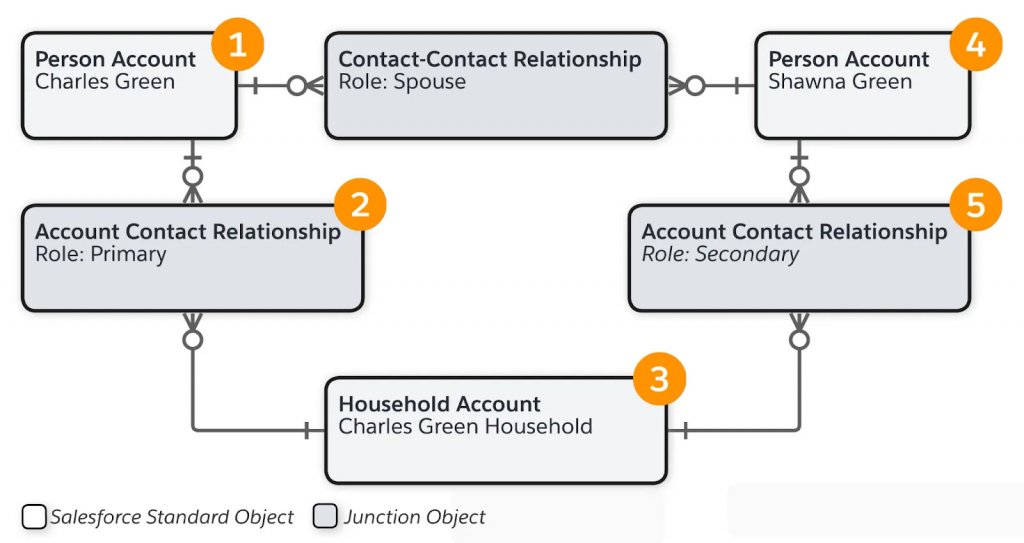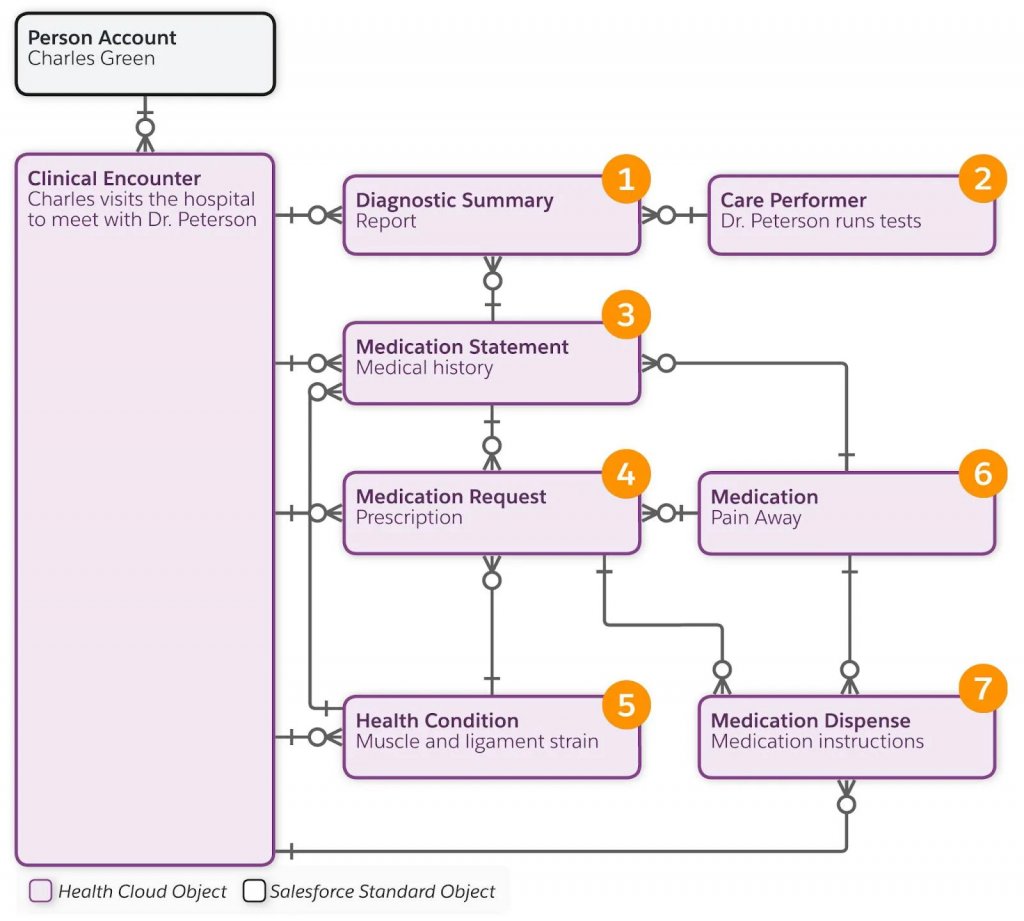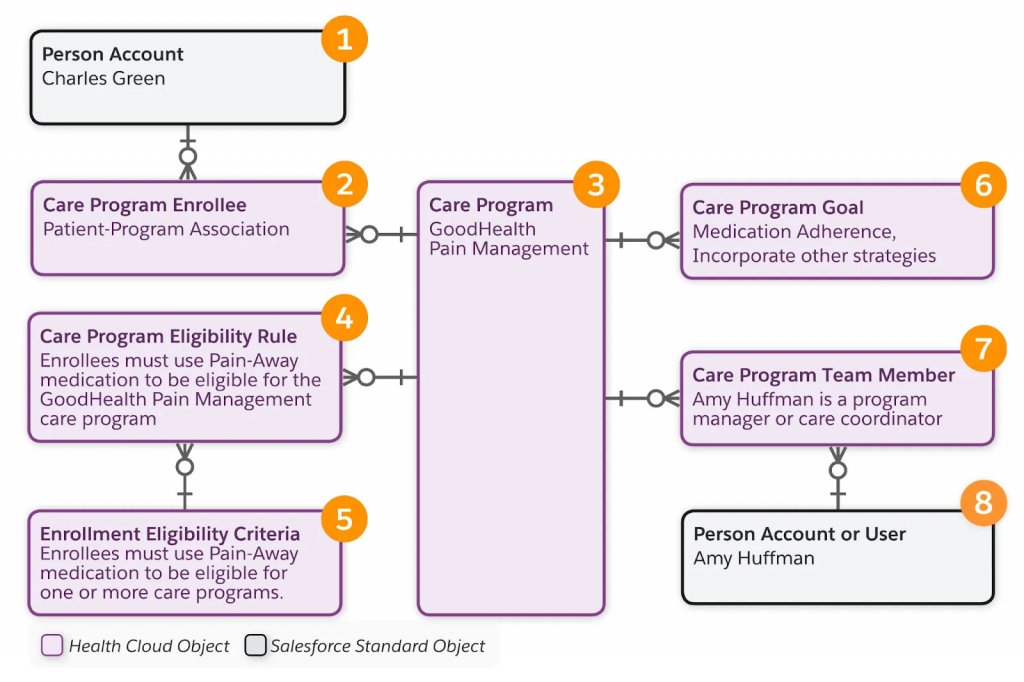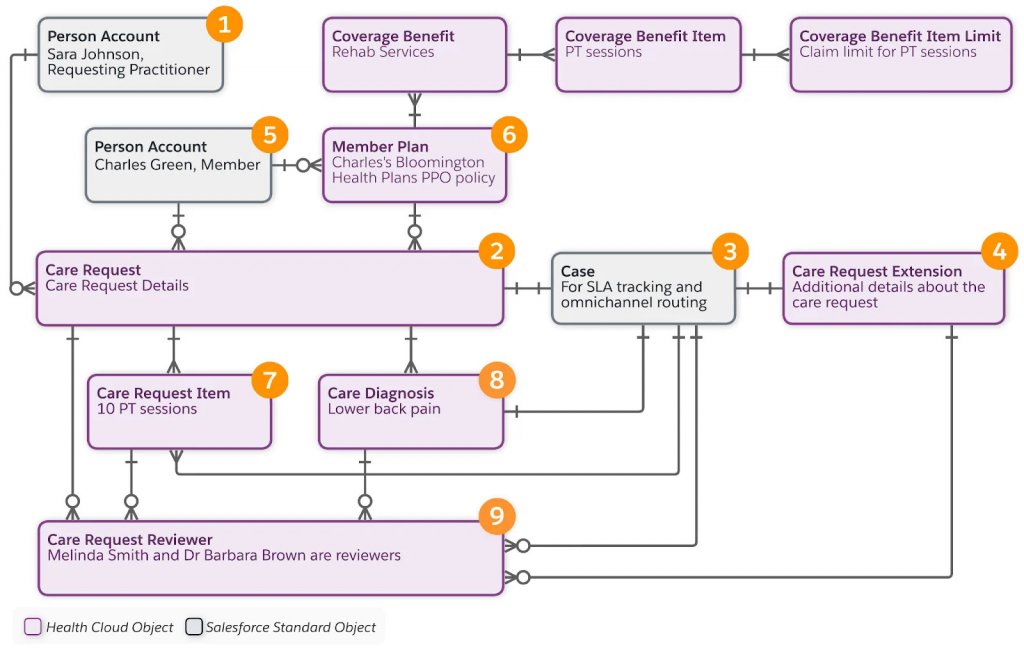Introduction
As hospitals rapidly adopt digital data-keeping, medical software development companies have become highly valued within the healthcare community. Among them, Salesforce Health Cloud stands out as one of the best healthcare mobile app development companies. It is in high demand for its exceptional UI design and offers valuable services like HIPAA compliance audit services. Salesforce healthcare cloud’s HL7 integration ensures top-notch service quality, widely praised for enhancing communication between healthcare professionals and patients and boosting customer engagement. In short, Health Cloud Salesforce excels in seamless functioning, making it a preferred choice among medical software development companies.
What is Health Cloud?
Altogether, Health Cloud utilizes cloud technology to provide a hassle-free experience for all stakeholders and customers in a healthcare organization. It enables real-time access to patient information, including medical history and upcoming health check-up appointments, for all users.
In the current global pandemic, integrating healthcare applications and software has become crucial to minimize unnecessary interactions and healthcare facility visits. The information stored on these health clouds can be utilized by doctors and pharmaceutical companies to predict health issues accordingly.
Salesforce developed Health Cloud in partnership with health and medical device companies particularly including Accenture, Deloitte, MuleSoft, Persistent, Philips, and PwC.
Health Cloud Benefits
Firstly, it is built on top of the Salesforce Platform and brings together clinical and nonclinical data into a single source of truth. Overall, helps organizations gain a 360-degree view of each patient to elevate the health experience, drive proactive engagement, and influence the best outcomes.
Let’s look at how Health Cloud solves the challenges of health care providers like Del Sol.
- Deliver care from anywhere: Expand patient access in the home, online, or in-person with digital self-service tools and integrated health data on one secure platform.
- Strengthen provider relationships: Efficiently manage the physician network and improve collaboration with a unified provider record and guided workflows.
- Gain a holistic patient view: Connect clinical data, social determinants, and preferences on one platform to understand the patient journey.
Capabilities for Providers
Health Cloud powers the Patient 360 Platform and solves the biggest challenges providers face. Let’s look at the key capabilities of the solution.
- Care management and coordination
- Provider relationship management
- Patient management
- Intelligent automation and scheduling
- Patient acquisition and outreach
Work with MedTech
Sales reps create site visits or virtual visits with the right resources, products, and assessment tasks. They anticipate shortfalls in the visits they create and proactively request product transfers when those shortfalls happen. Inventory management responsibilities can also be shared with clinical specialists.
MedTech Field Sales Reps
Sales reps like Evan must also be able to manage samples, loaners, and rentals. They perform the following tasks in the Health Cloud mobile app.
- Firstly, lead digital contract management.
- Create quotes, proposals, and request for proposal (RFP) responses.
- Develop a surgical case bill of materials (BOMs) and kitting.
- Further, manage personal inventory in multiple locations. This includes storing inventory at customer sites, Evan’s home, or in his vehicle.
- Transfer stock between field reps or manage the stop ship of a medical device from multiple inventory locations.
- Provide advanced parameter-based inventory search.
- Above all manage contract lifecycle.
- Ensure compliance by managing customer approvals.
- Use barcode scanners presently to add product serialization, IoT device traceability, and product expiration.
- Do the four Rs: recall, replenish, return, and repair management.
- Lastly, reconcile field inventory and Enterprise Resource Planning (ERP) inventory.
MedTech Field Clinical Specialists
Clinical specialists like Lauren schedule site visits to fulfill their surgical case orders and perform tasks defined in the visit. They also require easy access to inventory and order management wherever they go. Hence, they perform the following tasks in the Health Cloud mobile app.
- Perform all the tasks of a field sales rep.
- Attend surgeries and advise clients and medical professionals.
- Manage personal inventory in multiple locations.
- Transfer stock between field reps to eliminate missed surgeries or product sales opportunities.
- Ensure visibility into future inventory needs and shortfalls.
- Request replenishment of required inventory for upcoming visits accordingly.
- Fulfill inventory requests from other field reps, distribution centers, and inventory locations.
- Capture serialized products manually using barcodes for sales transactions or inventory transfer receipts.
- Reconcile field inventory and ERP inventory altogether.
- Reduce stale-dated inventory using product expiration date visibility.
- Reduce inventory overstocking by enforcing just-in-time inventory.
- Furthermore, track customer consignment inventory locations.
- Add customization using automation flows for common customer transactions, such as field transfers and returns.
Overall, Health Cloud helps MedTech companies like Cinnabar Medical to transform its business by boosting revenue, cutting operational costs, and automating processes.
Undeniably, it can better manage orders, inventories, and site visits. This enables them to bring in more business and strengthen client relationships. And clients like Kathryn can provide personalized patient care at the hospital.
Data Models for Healthcare
Following are the different types of data model used in Health Cloud
- Household Data Model
- Clinical Data Model
- the Health Insurance and Claims Data Model
- Care Program Data Model
- Social Determinants of Health Data Model
- Provider Data Model
- the Utilization Management Data Model
Health Cloud’s data models represent the objects and fields that support specific healthcare business processes. These data models underlie Health Cloud’s capabilities and features and provide insight into the kinds of data you can store in Health Cloud. You need to understand the data models to successfully implement and adopt Health Cloud
The Household Data Model
In the context of Health Cloud, the household data model maps the relationships between patients or members and the people and organizations who participate in their care. This map helps caregivers work more efficiently as they engage with the patient and provide them with the appropriate care.
The Account and Contact objects represent these caregivers and organizations. While business account records represent organizations. Person account or contact records in fact represent people. A relationship type determines whether the relationship is between an organization and a person, two organizations, or two people.
The Account Contact Relationship, Account-Account Relationship, and Contact-Contact Relationship junction objects represent the relationship types. Junction objects are objects with two parent-child relationships that are the key to creating many-to-many relationships between objects. This means that one parent record can relate to many child records and each child can relate to many parent records. For example, a single account record can relate to many contact records, while a single contact record in turn can relate to many accounts.
The Clinical Data Model
A patient’s healthcare journey takes them to multiple providers and healthcare facilities at different times. To ensure the accuracy of patient medical records, Health Level Seven (HL7) defines industry-recognized standards for how healthcare providers structure, store, and transfer medical records. This ensures the systems that different providers and facilities use are interoperable. HL7 defines two standards for this purpose:
- Fast Health Interoperability Resources (FHIR)
- HL7
The Clinical data model aligns with FHIR and supports many of the HL7 message types. This data model captures information from an Electronic Health Record (EHR) system via integration middleware. It displays information commonly associated with EHRs such as patient or member encounters, chronic conditions, allergies, medications, and immunizations.
The Health Insurance and Claims Data Model in Heath cloud
The Health Insurance and Claims data model in general provides objects for managing the ways healthcare is paid for. These objects then represent information about members and their employers, insurance coverage, and dependents. This data model therefore includes objects for claims submitted to a member’s health insurance company by an entity or person who provides a service, medication, or device to the member
The Care Program Data Model in Health cloud
Healthcare and life science organizations provide care programs to support patients on their health journeys. Their goal is to increase adherence to care plans, encourage wellness practices, and provide financial help. Care programs cover services such as patient outreach, access to care and medications, financial assistance, and fitness and wellness plans. The Care Program data model helps you capture those activities so you can use Health Cloud to plan and track them better.
Note that a care program is different from a care plan. A care plan helps the healthcare team coordinate care more efficiently for a patient with the goal of improving the patient’s health. You can link a care program to a care plan.
Care Program Enrollments and Goals
The Care Program object represents a set of activities, such as a patient therapy, financial assistance, education, wellness, or fitness plan, offered to participants by an employer or insurer. It includes data such as the parent care program and program sponsor, approved budget, and program start and end dates.
The Social Determinants of Health Data Model
Social determinants of health (SDOH) are the critical social and environmental factors that may become barriers to a patient’s or member’s wellness. The Social Determinants data model helps you gain insight into the physical environment and socioeconomic status of a patient so that you gain a holistic perspective on these factors. This helps you identify intervention tasks to address care barriers and reduce health setbacks for patients and members.
A common SDOH example is food insecurity. When patients and members don’t have an adequate number of meals or snacks daily, or the quality of their meals is poor, this can lead to higher-than-average visits to the emergency room. The intervention is to provide access to affordable nutritious food via food debit cards, food banks, food delivery services, farmers markets, and subsidized meal programs.
The Provider Data Model
The Provider data model represents healthcare providers, including individual practitioners and facilities, the network they participate in, and their specialties and credentials.
Healthcare Providers
When you model healthcare providers in Health Cloud, represent them as a person or an organization, and represent what they do.
The Account object with a Business record type represents providers that are organizations.
For people, use either person accounts or contacts, but we strongly recommend person accounts. Person accounts are a better fit for healthcare providers who are their own independent entity with practicing rights at a number of locations. These individuals have their own unique identification number, such as a National Provider Identifier (NPI), which follows them regardless of where they work. If you map individual providers as contacts, there are limited capabilities for these records.
The Healthcare Provider object represents what the providers do. This object stores business-level details about the healthcare organization or the individual, such as the provider type.
A healthcare provider record and person account combine to represent the FHIR Practitioner resource in Salesforce. The healthcare provider record is the base, and it references the person account record using the AccountId field.
If you model providers only as person accounts, you may not be able to use Health Cloud capabilities such as provider search. However, when you model providers using both the Healthcare Provider object and person accounts, then this ensures they’re aligned to the FHIR Practitioner resource and they can use provider search.
The Utilization Management Data Model
Utilization Management (UM) is the use of managed care techniques such as prior authorization to allow payers to manage the cost of health care benefits by assessing a benefit’s appropriateness before it’s provided, using evidence-based criteria or guidelines. UM ensures that patients receive the right care, at the right time, for the appropriate duration, in the right setting.
In Health Cloud’s Utilization Management, Omni Studio components combine to provide a guided user interaction for users who manage authorization request submissions and reviews. Omni Scripts are available to create and submit an authorization request, conduct admin, nurse, and medical director reviews of the authorization request, and conduct peer-to-peer reviews with the requesting provider.
Business Rules Engine components streamline approval processes, simplify complex lookups, and automate business decisions in the authorization request workflows.
The UM data model aligns with FHIR R4 for interoperability and integration with external systems. UM includes APIs and integration applications deployed on MuleSoft for uninterrupted request processing with external Electronic Health Record (EHR) and payer systems. These APIs align with the FHIR Da Vinci Health Record Exchange (HRex) implementation guide.
The Utilization Management data model provides objects for evaluating care requests such as preauthorization requests and prescription or medical service requests. This unit uses a preauthorization request as an example.
FAQ S
- What is Salesforce health Cloud used for?
Salesforce Health Cloud is a cloud-based technology to the world of healthcare. The primary objective is to keep all the patient information in one place. It helps health workers to have a complete view of patient records, and it also helps provide effective treatments.
2. What is cloud strategy for healthcare?
Cloud computing in the healthcare industry describes the practice of implementing remote servers accessed via the internet to store, manage and process healthcare-related data. This is in contrast to establishing an on-site data center with servers, or hosting the data on a personal computer.
For More Blogs: Click Here






